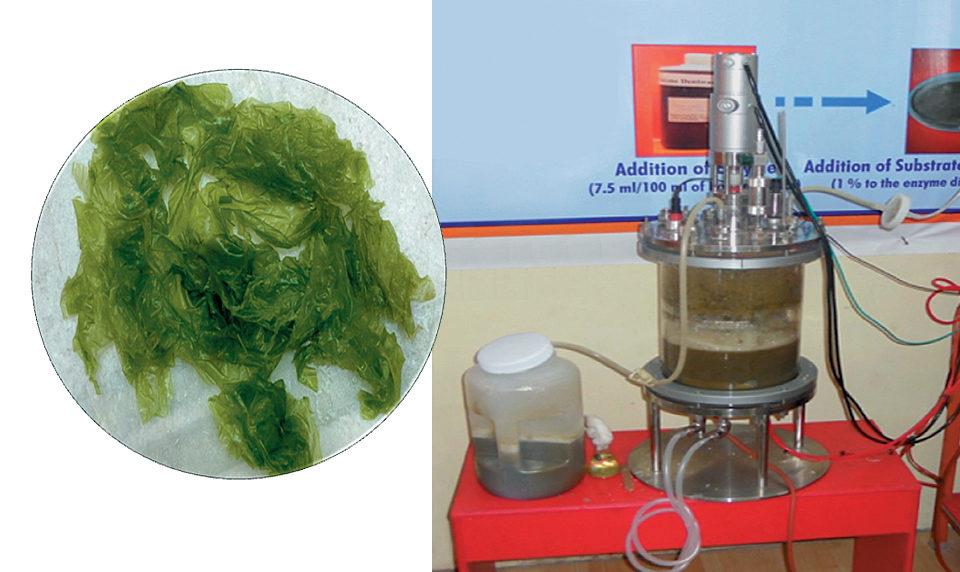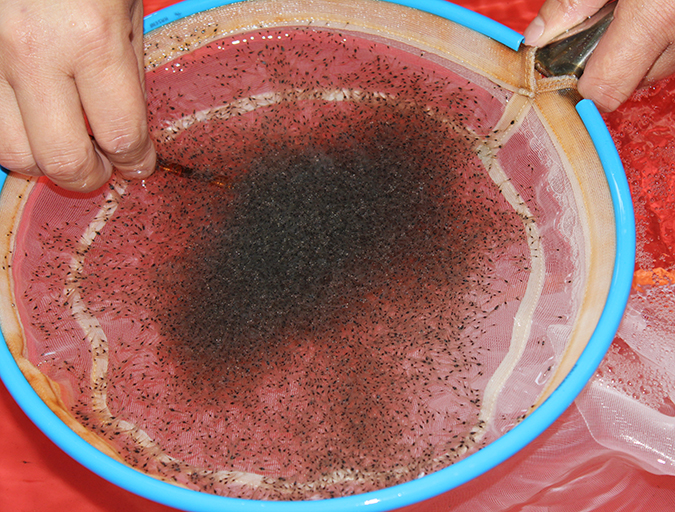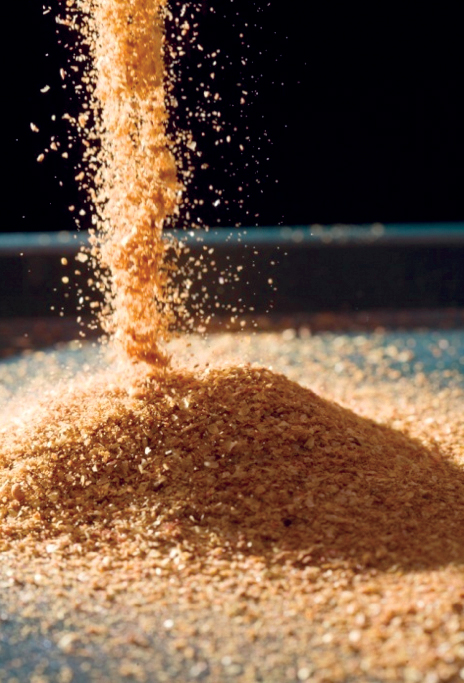Authors’ lab is working toward a formulation for black tiger shrimp larvae

Single-cell detritus (SCD) is a seaweed-based bioproduct produced through a combination of enzymatic and fermentative techniques. It can be prepared at particle sizes of 5 to 12 µ, making SCD ideal for marine hatchery feeding apart from its bioremediatory and probiotic roles in culture systems.
SCD can be fed to the larvae of both finfish and shellfish. The use of SCD as feed has been studied with oysters and Artemia by Motoharu Uchida in Japan. At present, the authors’ lab is working toward the formulation and production of SCD for Penaeus monodon shrimp larvae as a replacement for unicellular algae.
Trials have so far been successful. The expected breakthrough would be a major development in shrimp hatchery feeding technology by making nutrition management simpler and more cost-effective.
SCD features
Some of the features that SCD offers include the fact that with crude protein levels up to 35 percent, it is relatively nutritious and could partially or fully replace microalgae as a feed in hatcheries.
SCD particles can be produced in various sizes, as per need and species. The high cell concentration of SCD is comparable to that of algal concentrates. It can act as a bioremediatory agent and has proven probiotic effects.
Mass preparation of SCD is somewhat easier than the production and maintenance of microalgae. The production and use of SCD is an economically viable technology. In addition, single-cell detritus can be stored up to a year at room temperature.
Fermentation
Fermentation is one of the oldest biotechnological techniques that can be used for marine larval feed preparation. Uchida of Japan was the initiator of the formulation and production of SCD for marine oyster hatcheries.
For maximum utilization of the dietary potential of macroalgae, it is advantageous to perform thalli degradation under conditions regulating the catabolic losses. Mechanical or enzymatic fragmentation is effective for this purpose. Using viable bacteria for degradation is another alternative.
Another interesting characteristic of the detritus diet is the attachment of bacteria to the surface of the detritus, which can be achieved by incubating the bacteria for several hours with axenically prepared SCD particles. This method has some useful functions, such as anti-pathogenic activity and a vitamin-producing ability, and is expected to be useful in the development of a functional hatchery diet for suspension-feeding animals. The combination of lactic acid bacteria and yeast might have a synergetic effect for reducing the prevalence of pathogenic microbes in the production process.
Cellulase enzyme was used initially for the production of single cell units. Fermentation of seaweed was carried out by inoculating a lactic acid bacterium and yeast at a rate of 104 cfu/mL. A sugar substrate and nitrogen substrate were added to enhance the rate of fermentation and protein concentration. The process of fermentation was monitored continuously by estimating the lactic acid concentration, and measuring pH, microbial propagation rate and odor.
Two-phase protocol
SCD production has two phases. The first phase is cellulo-lytic enzymatic treatment of seaweed, which leads to single cell units. The enzymatic digest is further treated with bacteria and yeast in the second, fermentative phase. These two phases can be performed simultaneously or one by one.
Cellulolytic phase
Algae have cellulose in their cell walls that keeps the cells intact. When cellulose is digested, the individual cells are released and become single cell units. The enzyme cellulase is used for this purpose with the end product of cellulolytic digestion sugar. This phase has two roles: to produce single cell units and to produce sugars for the fermentative phase.
Fermentative phase
Two organisms are used in the fermentative phase to produce SCD: lactic acid bacteria and yeast. These organisms can be isolated from the natural fermented seaweed or other sources. In 2004, Motoharu Uchida used Lactobacillus brevis bacteria, and the yeasts Debaryomyces hanseii var. hanseii and Condida zeylanoides isolated from fermented Ulva. Bacteria like L. plantarum and L. casei can also be used for this purpose. Any suitable source of yeast can be used for fermenting the seaweed.
In the authors’ work, a consortium of microbes including L. plantarum and S. cerevisiae was used to produce 5- to 12-µ SCD to feed shrimp in a larval-rearing system. Sugar substrate was added to increase the fermentation rate, and a nitrogen source was added to increase the protein concentration, which is essential for shrimp larvae.
Lactic acid bacteria and yeast utilize the sugar produced by cellulolytic digestion and produce lactic acid. This prevents other organisms from growing and thus preserves the SCD.
Lactic acid bacteria also act as a probiotic and thus help to increase survival and maintain water quality. Yeast predominately acts as a bioremediatory agent, which enables culture systems to be run with little or no water exchange.
Large-scale production
SCD can be produced in large quantities in simple air-tight containers or more sophisticated fermentors or bioreactors specially designed for the purpose. The main difference between the two technologies is that it takes nearly two weeks for SCD to ferment in air-tight containers but only two to three days in a fermentor. Further, for purity and quality production, fermentors are recommended.
(Editor’s Note: This article was originally published in the July/August 2011 print edition of the Global Aquaculture Advocate.)
Authors
-
Dr. S. Felix
Fisheries Research and Extension Centre
Tamil Nadu Veterinary and Animal Sciences University
Chennai 600051
Tamil Nadu, India[32,109,111,99,46,111,111,104,97,121,64,120,105,108,101,102,97,103,117,115]
-
P. Pradeepa
Fisheries Research and Extension Centre
Tamil Nadu Veterinary and Animal Sciences University
Chennai 600051
Tamil Nadu, India
Related Posts

Health & Welfare
Recent developments in biofloc technology
Combining biofloc technology with bio-secure modular shrimp culture can make operations more sustainable and economically viable. For optimized biofloc production, lined ponds and reservoirs and high stocking densities are essential. Paddlewheel aerators keep dissolved-oxygen levels high.

Health & Welfare
Acclimating shrimp postlarvae before pond stocking
Shrimp postlarvae acclimation before stocking into the various growout systems (ponds, raceways, tanks) is a critical – and often overlooked, sometimes taken for granted – step in the shrimp culture process. Various water quality parameters should be changed slowly so that the young shrimp have the time to gradually adapt to the new conditions.

Health & Welfare
A holistic management approach to EMS
Early Mortality Syndrome has devastated farmed shrimp in Asia and Latin America. With better understanding of the pathogen and the development and improvement of novel strategies, shrimp farmers are now able to better manage the disease.

Aquafeeds
A look at corn distillers dried grains with solubles
Corn distillers dried grains with solubles are an economical source of energy, protein and digestible phosphorus to reduce feed costs and fishmeal usage.


